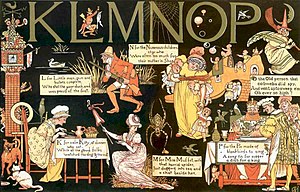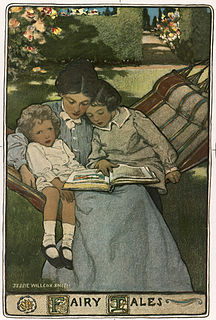
Children's literature or juvenile literature includes stories, books, magazines, and poems that are created for children. Modern children's literature is classified in two different ways: genre or the intended age of the reader.

Catherine Greenaway was an English Victorian artist and writer, known for her children's book illustrations. She received her education in graphic design and art between 1858 and 1871 from the Finsbury School of Art, the South Kensington School of Art, the Heatherley School of Art and the Slade School of Fine Art. She began her career designing for the burgeoning holiday card market, producing Christmas and Valentine's cards. In 1879 wood-block engraver and printer, Edmund Evans, printed Under the Window, an instant best-seller, which established her reputation. Her collaboration with Evans continued throughout the 1880s and 1890s.

A picture book combines visual and verbal narratives in a book format, most often aimed at young children. With the narrative told primarily through text, they are distinct from comics, which do so primarily through sequential images. The images in picture books can be produced in a range of media, such as oil paints, acrylics, watercolor, and pencil. Picture books often serve as pedagogical resources, aiding with children's language development or understanding of the world.
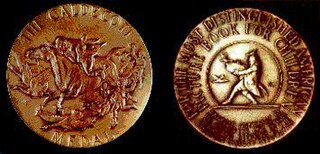
The Randolph Caldecott Medal, frequently shortened to just the Caldecott, annually recognizes the preceding year's "most distinguished American picture book for children". It is awarded to the illustrator by the Association for Library Service to Children (ALSC), a division of the American Library Association (ALA). The Caldecott and Newbery Medals are considered the most prestigious American children's book awards. Beside the Caldecott Medal, the committee awards a variable number of citations to runners-up they deem worthy, called the Caldecott Honor or Caldecott Honor Books.

An illustration is a decoration, interpretation or visual explanation of a text, concept or process, designed for integration in print and digital published media, such as posters, flyers, magazines, books, teaching materials, animations, video games and films. An illustration is typically created by an illustrator. Digital illustrations are often used to make websites and apps more user-friendly, such as the use of emojis to accompany digital type. llustration also means providing an example; either in writing or in picture form.

Walter Crane was an English artist and book illustrator. He is considered to be the most influential, and among the most prolific, children's book creators of his generation and, along with Randolph Caldecott and Kate Greenaway, one of the strongest contributors to the child's nursery motif that the genre of English children's illustrated literature would exhibit in its developmental stages in the later 19th century.

Charles William James Keeping was an English illustrator, children's book author and lithographer. He made the illustrations for Rosemary Sutcliff's historical novels for children, and he created more than twenty picture books. He also illustrated the complete works of Charles Dickens for the Folio Society.

Randolph Caldecott was a British artist and illustrator, born in Chester. The Caldecott Medal was named in his honour. He exercised his art chiefly in book illustrations. His abilities as an artist were promptly and generously recognised by the Royal Academy. Caldecott greatly influenced illustration of children's books during the nineteenth century. Two books illustrated by him, priced at a shilling each, were published every Christmas for eight years.
Helen Sonia Cooper is a British illustrator and an author of children's literature. She grew up in Cumbria, where she practiced literature and piano playing. She currently lives in Oxford.
Nonny Hogrogian is an Armenian-American writer and illustrator, known best for children's picture books. She has won two annual Caldecott Medals for U.S. children's book illustrations. Since childhood she prefers folk and fairy tales, poetry, fantasy and stories.
Molly Garrett Bang is an American illustrator. For her illustration of children's books she has been a runner-up for the American Caldecott Medal three times and for the British Greenaway Medal once. Announced June 2015, her 1996 picture book Goose is the 2016 Phoenix Picture Book Award winner – that is, named by the Children's Literature Association the best English-language children's picture book that did not win a major award when it was published twenty years earlier.

Edmund Evans was an English wood-engraver and colour printer during the Victorian era. Evans specialized in full-colour printing, which, in part because of his work, became popular in the mid-19th century. He employed and collaborated with illustrators such as Walter Crane, Randolph Caldecott, Kate Greenaway and Richard Doyle to produce what are now considered to be classic children's books. Although little is known about his life, he wrote a short autobiography before his death in 1905 in which he described his life as a printer in Victorian London.

The illustration of manuscript books was well established in ancient times, and the tradition of the illuminated manuscript thrived in the West until the invention of printing. Other parts of the world had comparable traditions, such as the Persian miniature. Modern book illustration comes from the 15th-century woodcut illustrations that were fairly rapidly included in early printed books, and later block books. Other techniques such as engraving, etching, lithography and various kinds of colour printing were to expand the possibilities and were exploited by such masters as Daumier, Doré or Gavarni.

Chromoxylography was a colour woodblock printing process, popular from the mid-19th to the early-20th century, commonly used to produce illustrations in children's books, serial pulp magazines, and cover art for yellow-back and penny dreadfuls. The art of relief engraving and chromoxylography was perfected by engravers and printers in the 19th century, most notably in Victorian London by engraver and printer Edmund Evans who was particularly good with the process, producing a wide range of hues and tones through color mixing. Chromoxylography was a complicated technique, requiring intricate engraving and printing for the best results. Less expensive products, such as covers for pulp magazines, had to be produced with few colours, often only two or three, whereas more intricate and expensive books and reproductions of paintings used as many as a dozen or more colors. For each colour used, a separate woodblock had to be carved of the image being reproduced.
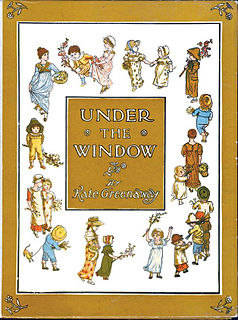
Under the Window: Pictures & Rhymes for Children was Kate Greenaway's first children's picture book, composed of her own verses and illustrations. Selling over 100,000 copies, the toy book was a commercial success, helped launch Greenaway's career as a children's book illustrator and author in the late 19th century as well as starting what became known as the "Greenaway vogue".
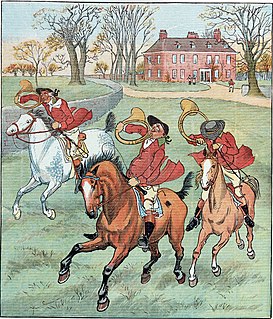
The Three Jovial Huntsmen (1880) was a popular British picture book illustrated by Randolph Caldecott, engraved and printed by Edmund Evans and published by George Routledge & Sons in London. The toy book, which is a variant of the folklore song The Three Huntsmen, was well-received, selling tens of thousands of copies.

Jon Klassen is a Canadian writer and illustrator of children's books and an animator. He won both the American Caldecott Medal and the British Kate Greenaway Medal for children's book illustration, recognizing the 2012 picture book This Is Not My Hat, which he also wrote. He is the first person to win both awards for the same work.

Hugh Thomson was an Irish Illustrator born at Coleraine near Derry. He is best known for his pen-and-ink illustrations of works by authors such as Jane Austen, Charles Dickens, and J. M. Barrie. Thomson inaugurated the Cranford School of illustration with the publication of the 1891 Macmillan reissue of Mrs. Gaskell's Cranford.

Dean & Son was a 19th-century London publishing firm, best known for making and mass-producing moveable children's books and toy books, established around 1800. Thomas Dean founded the firm, probably in the late 1790s, bringing to it innovative lithographic printing processes. By the time his son George became a partner in 1847, the firm was the preeminent publisher of novelty children's books in London. The firm was first located on Threadneedle Street early in the century; it moved to Ludgate Hill in the middle of the century, and then to Fleet Street from 1871 to 1890. In the mid-20th century the firm published books by Enid Blyton and children's classics in the Dean's Classics series.
Holly Meade was an American artist best known for her woodblock prints and for her illustrations for children's picture books.



